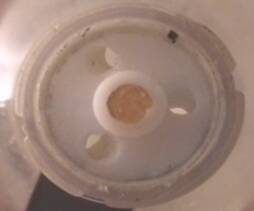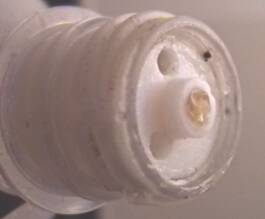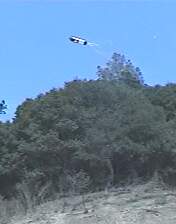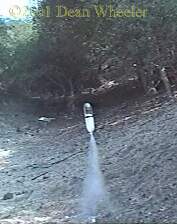Look Ma, no fins!
Modern full-size rockets fly without fins. They are able to fly stably (most of the time!) by having a nozzle which can variably direct the thrust to keep the rocket going in the proper direction. This kind of active control requires sophisticated computer avionics.
Can a finless water rocket be made to fly stably with passive control? This bizarre question was on my mind in 2001. As described below, I built and modified a rocket that nearly reached this goal. The rocket used a special nozzle to induce rotation about the bottle axis and therefore create gyroscopic stability.
The bottle
The 2-liter bottle was “guppied” somewhat to improve the aerodynamics of its shape. I added weight in the form of a strip of linoleum (fairly dense flexible vinyl flooring) around the circumference. The strip is secured to the bottle and streamlined by an outer wrap of vinyl electrical tape. The distribution of the weight on the circumference increases the moment of inertia for rotation about the bottle axis—something that will help preserve the spin after the thrust is concluded. The rocket’s center of mass is approximately coincident with the center of pressure. It is my intention that the rocket destabilize near apogee as the axial spinning slows down.
The nozzle
The nozzle is a piece of scrap polyethylene which I machined using a lathe and a drill bit chucked in a milling machine. The piece originally had a hole down its axis which I plugged with epoxy. I drilled three nozzle holes of diameter 3.3mm. The holes each make an angle of 25 degrees from the bottle axis and are symmetrically disposed about that axis. Incidently, for the mathematically inclined, the path that the water travels as it streams through the holes lies on the surface of a hyperbola.


Preliminary flight
This 93KB MPEG video (click on the image below) shows one of the preliminary launches. The bottle was about half full of water and was pressurized to 6.2 bar (90 psi). The rocket destabilized fairly rapidly but was still able to reach an estimated apogee of 30 meters (98 feet). I'm quite fond of this video!
Modified design
I decided that I need to lengthen the rocket by adding a long nose cone. My rationale was to increase the moment of inertia for rotation perpendicular to the rocket axis, i.e. to slow down the rate of change in the rocket's direction. The nosecone is internally weighted with the same circumferential strip of vinyl flooring used on the original rocket. I also added weight to the tail-end of the rocket to keep the center of mass about 1/4 caliber behind the center of pressure (estimated) and again to increase the moment of inertia. Recall that my intention is for the rocket to destabilize near apogee.
Results
As hoped, lengthening the rocket did seem to improve stability. Unfortunately the rocket, now weighing close to 200g, was a bit heavy and I couldn't get it to go higher than about 35-40m even on the more stable flights. Traditional “open-mouth” nozzles are more efficient than this one at boosting the rocket, because for traditional nozzles there is less frictional loss and the thrust is directed along the rocket axis. In all cases my rocket was still spinning quite rapidly at crashdown. More than once I observed a few mL of water left inside the rocket after crashdown, indicating that some water was spun up to the sides of the rocket and not ejected during boost.
There was a gentle wind blowing generally in the direction away from the video camera; this may have contributed to instability in some cases.
Here are MPEG videos of three of the six launches I made, with some comments after each image. The
videos average 350KB apiece. For full effect, I encourage you to play them back in slow motion
(using a player such as Irfanview).
This was the first flight of the newly modified spinning rocket. The rocket was about 1/3 full of water. Pressure was 6.2bar (90psi). The rocket seemed to recover stability after a fairly erratic boost and descended tail-first.
I reduced some of the weight on the tail for this one. The rocket was 1/2 full of water and pressurized to 5.5bar(80psi). Descent was much like the previous one, that is, mostly tail first.
This was the last flight of the day. I had removed all tail weight so that the center of mass was about 1/4 caliber ahead of the center of pressure. There was very little water added and pressure was 7.5 bar (109psi). Unlike the flight shown above, the tree decided to hang on to my rocket. With some rock throwing, however, the tree relented.
Conclusion
I still maintain hope in finding a more successful finless rocket design. In the future I want to increase the bore of the nozzle holes. This will decrease frictional losses in the nozzle, thus increasing boost power, and also lesson opportunities to destabilize during boost. Because this rocket rides the cusp of stability at all times, it is better to make the thrust phase conclude a bit more rapidly, even if it sacrifices some of the fun of a slow boost.




